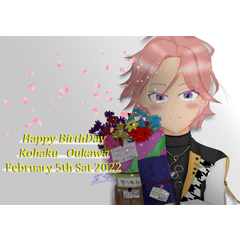[Video] How to add borders and shadows to drawn characters
I will explain how to add borders and shadows to the drawn characters of the manga and how to draw the drawn characters.
The video version is here ↓
1. Add borders and shadows to drawn characters
I will explain how to add white borders to black characters and tones to characters.
The word "burn" can be drawn by drawing with a round pen and then erasing the edges with an eraser.
You can draw more easily by using the solid correction pen. (The lower row is drawn with a solid correction pen)
The first is to add a white border to the black characters.
Select [Boundary Effect]-> [Border] in the layer properties to make the border color white.
Adjust the thickness of the border to your liking.
This is the end.
Next is how to add a black border to white characters.
Change the border color of the previous layer to black.
With white as the drawing color, click [Change line color to drawing color].
This is the end.
Next is how to put a grade tone on the letters.
Select "Manga Gradient" from the Gradient Tool.
After dragging from top to bottom to apply the tone, place the tone layer on top of the black border character layer.
If you do "Clipping on the lower layer", only the character part will be toned.
This is the end.
I explained with gradation tone, but it can also be applied with normal tone.
Next is the watermark + white border method.
Create a new layer with nothing drawn under the black border layer and combine it.
I think that the layer expression color will be in the "color" state when combined.
Click [Convert Brightness to Transparency].
Then only the white part can be seen through.
Add a border to it and you're done.
The last method is to add a shadow.
Duplicate the layer that was combined earlier (the one whose expression color is color).
With the drawing color set to black, change it to black with [Change line color to drawing color].
[Move layer] Use the tool to move the Kage layer slightly toward the lower right, and you're done.
The course to add borders and shadows to the drawn characters with this is over.
2. Draw different types of characters
Next is the shape of the letters.
Even with the same letter "Doki", the impression changes just by changing the shape.
I think that the tapered type of A can be used when you are crushed by your favorite person.
You can use it when you are surprised.
I personally think that this shape is not too pop and not too serious and is highly versatile.
B's emotional movement is similar to A's crush, but it's a pretty pop shape
I think it is more suitable for comical scenes than A.
C looks pretty surprised.
It looks like you're scared, so you can use it for horror scenes.
D is a little surprised.
I think that this shape is also easy to get used to because it is not very assertive.
Then, I will explain how to draw each character.
First is the shape of A.
This is drawn using [Boundary effect] → [Border].
Draw quickly using a pen that has an entry / exit correction.
It is good to draw with the image of making the characters a little vertically long.
(Click here for how to make a pen with correction ↓)
This is completed.
Usage example ↓
(The text has a white border, but if you add a border effect (border) to the layer folder and put the text layer in it, the border will be added.)
Next is the B shape.
This uses a felt-tip pen.
Like A, draw using [Boundary effect] → [Border].
It is an image to draw in a circle.
I think it's a good idea to draw some of the letters thicker.
After drawing the outline of the character, create a new layer.
Set the border thinner than the contour layer and draw the gloss of the characters.
I think it has a more pop feel.
This is completed.
Usage example ↓
Next is the C shape.
This is drawn as it is without using the boundary effect.
Use a grainy pen.
First, draw with a thick brush size.
Next, add a brush with a smaller brush size.
This will give the letters momentum.
Before addition → After addition
(The one on the right is the one with the added part blue)
This is completed.
Usage example (a little horror caution) ↓
The last is D.
Draw as it is like C.
Draw with a Becho brush.
Like A, it is an image that is drawn slightly vertically.
This is completed.
Usage example (white border is added for easy viewing.) ↓
3. Summary of usage examples
I tried arranging the usage example images.
I introduced 4 patterns, but there are many other shapes, so
Try to find it or create your own.
This is the end of this course.
I also post other courses on pixiv and Twitter.
I would be grateful if you could check it out.
Thank you for reading this far! !!
























Comment